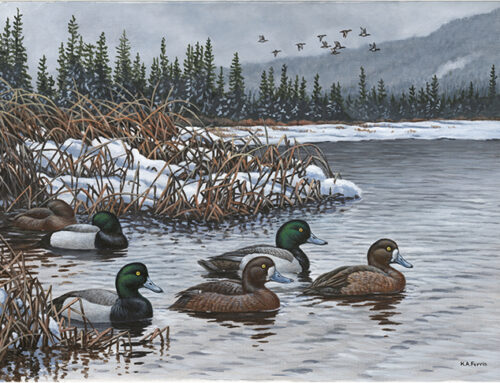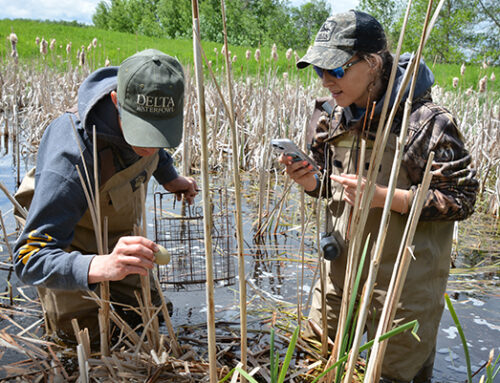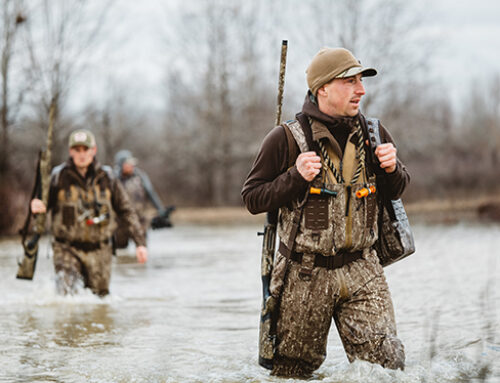Atlantic Flyway Goose Seasons Shortened, Mallard Limits Reduced for 2019-2020

Atlantic Flyway waterfowlers in the United States will have reduced bag limits on geese and mallards during the 2019-2020 season. The mallard limit will drop to two daily, only one of which may be a hen, while Canada goose seasons in the Atlantic population zones will run just 30 days with a restrictive harvest. The Atlantic Flyway Council approved the regulations in September, and they were formalized by the USFWS Service Regulations Committee on October 16 and 17.
Canada goose hunters in Delaware, Maryland and Virginia face a limit of one bird daily, while the rest of the flyway’s Atlantic population zones will be permitted two daily. The move was largely spurred by poor Canada goose production in spring 2018, plus a 30 percent decline among Atlantic population Canadas in the most-recent breeding population survey.
“Atlantic Flyway biologists estimate it was the worst Atlantic population Canada goose production in 22 years,” said John Devney, Delta’s senior vice president, who attended the Atlantic Flyway Council meeting. “The collaborative Atlantic population banding effort accounted 30 juveniles for the 3,000 geese banded. That is abysmal.”
Atlantic population goose regulations are governed by a three-year average population estimate. The threshold for conservative regulations is 150,000 birds, and while this year’s estimate was 155,000, poor goose production compelled the Atlantic Flyway Council to act.
“Unlike most ducks, Canadas generally have lower reproduction potential and there is a relationship between hunter harvest and survival,” Devney said. “So, with an estimate that’s close to the edge with poor production on top of that, it’s appropriate for the Flyway Council to be cautious. Nobody wants to revisit the days when there was a moratorium on Canada goose hunting on the Delmarva Peninsula.”
The reduced mallard limit is in response to a longer-term issue. Population surveys indicate breeding mallards in the northeast United States have declined about 20 percent since 1998 (despite increasing 7 percent in this year’s survey to 482,100, they are 32 percent below the long-term average).
The original proposed action to reduce mallard harvest was a limit of two mallards, both of which could be hens. Delta did not dispute the need to take action, but advocated for consideration of a limit of three mallards and one hen — potentially providing more opportunities for hunters while reducing adult hen mortality. The effort did not succeed.
However, surveys by the USFWS found that Atlantic Flyway hunters favored further restricting the hen mallard limit to one daily. And in May, Delta Waterfowl delivered a survey to all Atlantic Flyway members, which found 17.9 percent supported a limit of two mallards with one hen, while only 6.6 percent preferred a limit of two mallards with two hens (63.9 percent favored a limit of 3 mallards, one hen). Ultimately, given the hunter-feedback, the Council settled on a daily bag of two mallards, only one of which can be a hen.
“I credit Atlantic Flyway duck hunters for being vocal and the Flyway Council for considering their wishes,” Devney said.
Notably, Atlantic Flyway duck hunters will retain a 60-day duck season for 2019-2020, as determined by a multi-stock harvest model employed by the Council for the first time. Previously, Atlantic Flyway duck season lengths and overall bag limits were set using a mallard-based model — as they continue to be in all other flyways. Now, the flyway’s frameworks will be established based on the aggregate population status of four key Atlantic species: green-winged teal, ring-necked ducks, wood ducks and goldeneyes. Mallard and black duck limits will be considered independently, just as scaup, canvasbacks and pintails are elsewhere.
Why?
Although eastern mallards are declining, mallards occupy a smaller percentage of the Atlantic Flyway harvest than elsewhere, and the breeding habitat of eastern mallards is distinct from other major species important in the Atlantic Flyway.
“If you looked at the estimate of breeding mallards and breeding mallard habitat in the Central Flyway in a given year, it’d be pretty descriptive for all prairie-nesting ducks,” Devney said. “But mallards are a less appropriate surrogate for the habitat and breeding biology of the important eastern ducks considered in the multi-stock harvest strategy.”
Delta Waterfowl believes the multi-stock harvest model will result in better long-term outcomes for hunters.
“The Atlantic Flyway Council, especially, and also the U.S. Fish and Wildlife Service, deserve a great deal of credit for getting out of a difficult situation, performing really strong technical work and delivering a solution that equally considers ducks and duck hunters,” Devney said. — Kyle Wintersteen






Why are only a few hunters required to kill 1 goose, while others in the same flyway kill 2? That makes no sense to me. 1 for all hunters or 2 for all hunters
I would still like to see the states that have liberal bag limits on Canada geese in March to really consider giving this season up for a short term or cutting back the daily bag limit. I really think if you think about it,this March season that some states have has to be shooting some migratory birds heading back to breeding grounds. Just a thought
How about a reduced price for hunting license?
Reducing prices on licenses will take money away from The research and conservation we need in our Atlantic flyway we need to know this information that way we can make decisions like this. I think a little sacrifice is fine that way we don’t put ourselves where we used to be with a moratorium.
😲 Really, let’s hunt NY, in the area I hunt there is so many Mallards. Mid season all we see it’s high numbers of huge flocks flying. I could see and understand our “late season” and hens, but this is taking it to far. 🙄
I feel same way. All we get is mallards. And tons of them here in upstate ny
I saw 0 Mallards in PA this year while hunting
Would cutting out of the September resident season help !
It a shame the decision doesn’t treat Md. fairly. All states in the flyway should be equal. If you think Pennsylvania, New York and New Jersey along with other states in the Atlantic flyway aren’t a larger part of the issue you are not doing your research. Hunter blogs and post from these areas tell the real story. The pictures and stories from these areas of people posting kill numbers like a trophy is disgusting.
Next, there are more breeding pairs and offspring in my area then I’ve seen in 25 years. Fact the bird will breed where they want to and just because the traditional ground are lacking does not mean there is a problem. You cant make a bird migrate if it doesn’t want to or need to go as far.
My last comment is that changing limits only affect hunters who obey the law. Maybe look into adding a rotating closed day for over hunted days like Fri and Sat. similar to commercial crabbing. This would allow DNR to concentrate there efforts to ensure and protect water foul hunting for all.
I got the chance to hunt Maryland a couple years back and I was amazed at all the Canada’s I seen. I was even more astonished to see that hunters were only allowed 2 birds per day. I’m from SC and our daily limit was 5 except for early season it was 15. I totally agree with you that we should all be held to the same number.
I really like your idea !!!! Being realistic and conservative. Truth of the matter is our northern states have always held a generous bag limit and season, while the southern states have to pay for their mistakes.
I believe in trends and feel a need to understand them. I also beleave in first hand observation. I have been hunting ducks in northern Vermont for 40 years. The mallard population is higher than ever. So I just don’t get it. Going from 4 to two seems a bit over the top. There will still be a 2 bird limit on Blacks, Pintails and Redheads? Are they saving the Mallard population is at the same level as theses other duck species?
Is Canada taking the same steps in reducing the Mallard bag limit? Do the beleave the trends?
With that said I would hope the people making the changes are in the field making first hand observations and not settling behind a desk crunching numbers.
Sad
As conservationist and preservationist, we as duck hunters can do our part by not harvesting hen mallards. My experience of years of waterfowling the northern Lake Champlain region is that typically we see a 70-30 or 60-40 ratio of drakes to hens. We can help close that gap. Also supporting Delta Waterfowl is very important. They are doing amazing work.
First question is how did we get to this point? The population didn’t just drop in one breeding season. In NY we have 3 and 5 bird zones during the regular season, drop the five limit down. September season is 15 bird limit, unplugged guns, and e callers. The last week and half to two weeks of the September season guys are taking huge limits of migrators, why does nobody address this? The 8-10 day 5 bird limit March season set up to reduce the local population is doing the opposite, migrating pairs are being harvested. Personally I believe poor management on the Feds is a big part of this decline.
This makes no sense at all. The count and breeding statistics have been available since the mid-summer. If the harvest needs to be reduced, then it should have been implemented in the 2018/2019 season, not 2019/2020. So, now hunters can continue to take birds and further reduce the population making a bad situation worse. On the other hand, what happens if the 2019 breeding season is a huge success and the numbers return to the previous counts? Will they eliminate the reduced season and bag limits? Probably not. Makes absolutely no sense.
What a drastic change in the mallard bag limit. Didn’t they see this coming?? With all the money the Feds receive from our now $25 duck stamp and all thier claims about preserving wetlands you’d think we’d see new projects in our area. I think it’s time for the money to be accountable. We all hear about the grand projects in the Midwest that are happening, but here in the Fingerlakes projects are few and far between. Going from 4 to 2 mallards is a big hit for the guys that put so much time and effort into this sport/passion. My family manages 3200 acres along the Geneseo river and we’ve been doing our part with improving habitat for our local ducks. We maintain 30 or more mallard nests and about the same number in wood duck boxes. With all this hard work we’ve done we’ve seen a great improvement in broods in our area, and when I told my family about the governments decision to cut our limit in half it left them speechless. I think cutting the season shorter or even dropping it to 3/day would be less of a sting for all of us. And as for the geese stop the march season because what we see here at that time is all migratory birds.
Ive seen dramatically reduced bag limits in my past… many quit hunting, quit buying duck stamps, quit supporting conservation groups.
Be one of people who stay active and when numbers rebound you can be proud of your efforts.
As long as these changes to the bag limit were well thought out and not a knee jerk reaction I am ok with it. I think reducing to 3 mallards with 1 hen would have been better but as long as this is temporary I am ok with it.
They should allow hunting only on Friday’s and Saturday’s all season long so the working man can get out and hunt.
I hunt the eastern shore of Maryland, I see a large number of Mallards during early and mid seasons. Geese are always good,and this year we have seen a large number of Pintail ducks. I thought 2 geese was small enough, now with one its not worth the effort to setup for geese unless you are hunting ducks. Lucky for me I see massive numbers of snow geese and other species of ducks or I would not keep my farms. What does this do for outfitters, do they have different rules. I just know that I hunt VA because of Sunday hunts and 5 bird limits, I believe that the law should cover the whole east coast not just some states.
If this is such a problem then change it all for everyone
Its always been a rare sight to see and work mallards let alone bag them here in SC. And when the rare occasion of bagging one does occur the chances of it being a released bird from one of the many private clubs/plantations we have are high. I hear stories how mallards were everyway back in the day but for the last 10 plus years of hunting public/private lands here we just don’t see the wild mallard numbers like other states do and every year seems to be worse and worse. So far as lowering the daily bag limit of mallards from 4 to 2 in my opinion really won’t effect your day to day public hunters here in SC. The private clubs and plantations on the other hand that spend the big money to buy and release thousands and thousands of “tamies” each year may be a little salty about it though but if the experts think it will help with the mallard population they have my vote because at the end of the day no one here in SC limits out on WILD mallards regularly.
I hunt the MD eastern shore for the last 40 years and also I am a professional waterfowl guide. This past season is a duplicate of 1989 and 1990 hunting seasons. It needs to be closed for Canada geese now!! It’s beyond common sense that the AP population be open for two birds in other states and only one in MD, DE AND VA.
Close it now throughout the whole AP Flyway. Anything less is very shortsighted.
I doesn’t matter through most of PA. They could make the duck limit one total (all species). That’s about how many we get each outing. Many times zero. We see maybe 15 ducks a day max. There is nothing coming down the Susquhanna anymore. If you don’t go the first week of ducks and get some wood ducks, you may as well stay in bed the rest of the year. I’m moving on to doves and crows. They are way more dependable. Every year has been worse than the last since the late 90’s.
Also, if the bad limit of geese drops, there will be no reason to go. We do actually see some geese in Central PA.
This is a rediculous knee jerk reaction . I am at the bottom of the flyway in Florida. I have not seen a mallard in 3 yrs and I haven’t seen a flock of mallards in 7 years. In the miracle that I get a chance at a 4 duck limit of green I would want that opportunity. It make me sick to think that all the money we spend in the name of “conservation” appears to be wasted . By the way I was sent the public survey about this topic from USFWS and told them I did not approve. I feel by the time they solicite public input , the decision has already been made.